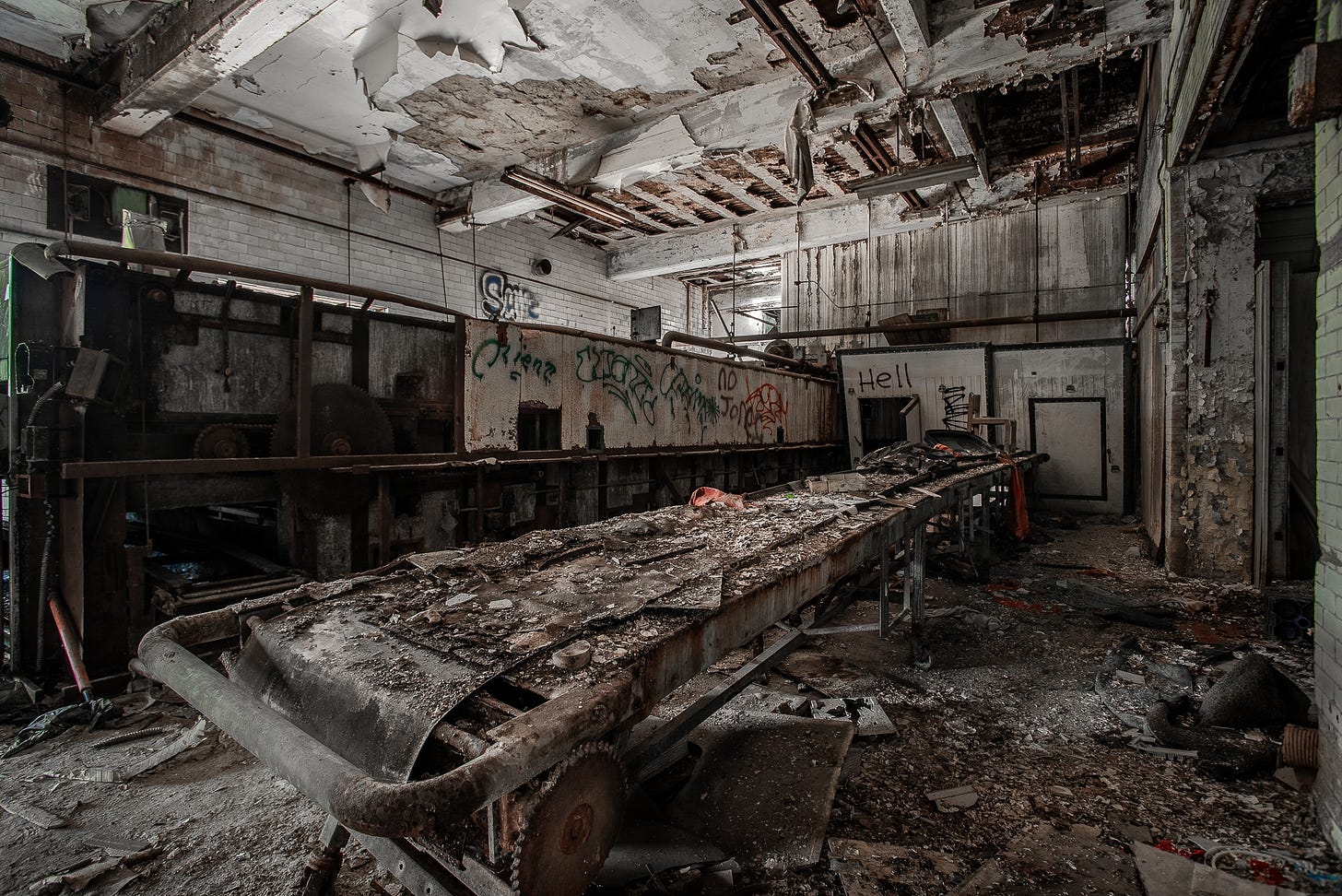Dust, Rust and the Magic of Abandonment Photography
Sometimes you find and document something that sparks discussion, wonder and best of all, conversation...
There’s a certain smell to dust—dry, sharp, and a little sad. It clings to your clothes after hours spent wandering old rail yards or peering through the busted-out windows of a crumbling warehouse. It covers every surface in an abandoned church and motes of it float in sunbeams within an decaying old school roof. That smell of dust; that’s usually when I know I’ve found the right place to start shooting.
The dusty, rusting crust of the abandoned Hough Bakery headquarters in Cleveland, Ohio.
A lot of the places I end up photographing come into view by accident. I do a lot of driving around Cleveland, Ohio, where I’m based, and it’s usually the side streets—the ones with potholes and factories held together with rust and graffiti—that yield the best results. Sometimes it’s a place that’s clearly abandoned, and we make plans to go inside and document whatever’s been left behind. Other times, it’s the industrial aesthetic itself that draws us in: the textures, the colors, the quiet ache of something once vital now fading from view.
Cleveland-Cliffs steel mill; Cleveland Flats.
My first love as a photographer is industrial sites. Sometimes it’s the empty shell of a long-dead factory, other times it’s rusting bridges or battered boxcars sitting quietly on a forgotten siding. I’m always on the lookout for interesting lines, rusted machinery, vintage signage, and architectural remnants from an age when even utility had style. I look for artifacts—things people left behind without realizing they’d one day tell a story. Each one holds a fragment of the past. Each one belonged to someone.
Industrial may be my first love, but now and again, I find myself in other types of locations, some which lead to a treasure trove of left-behind artifacts, a tableau of stories silently being told, and a brain full of curious questions. Such a place came into frame last summer, and better yet, I was able to share a portion of the stories that came from this location with hundreds of other people, all who joined in my wonder at the things left behind.
Truly, one of the most surprising and meaningful responses I ever received came after a post I made on X/Twitter last year from this place. I had taken a photo inside an abandoned funeral home in Detroit, a place that had been closed for decades. This funeral home was known for being the place that Harry Houdini was laid out before being interred in 1926. The second floor was falling apart, but in a closet—half-rotted and split open—were the remnants of a vinyl collection. Shelves of records from the 1920s and '30s had collapsed in on themselves, spilling hundreds of dusty old discs across the wooden floor like the room had vomited up forgotten history.
A musical crime; a vinyl lover’s worst nightmare…
I posted the image, not thinking much of it—just another striking moment of decay and time colliding. But within hours, it went viral. People responded from all over: vinyl collectors, gospel music lovers, archivists, and curious onlookers asking, “What was on those records?” As a music nerd myself, the response was incredible. Even better, some local music conservators reached out to investigate. They hoped to salvage and digitize whatever they could. The records, it turns out, were gospel and piano music—rare recordings, likely some of the only copies left on Earth.
I still haven’t heard what came of the recovery effort, but knowing that one photograph might help preserve nearly century-old music for future generations is one of the most rewarding outcomes I’ve ever experienced. It reminded me why I do this—not just for the thrill of the explore or the aesthetics of decay, but for the stories, memories, and conversations these places spark.
There’ve been other moments too—small but meaningful ones. A former steelworker once messaged me to say he used to work in one of the factories I shot. He remembered his first job sweeping the floors in the ‘70s, and how the cracked windows in my photo were the same ones that used to let in the sunrise on the early shift. Another time, a young follower told me they’d never seen a building like that up close and asked if those places were even real.
The once bustling floor of a clothing factory in Cleveland, Ohio; now empty and slowly decaying…
That’s the magic of photography in these forgotten spaces. They’re more than just ruins. They’re memory vaults. And every now and then, if the light hits just right and someone happens to be scrolling at the right moment, a single image can pull the past into the present—long enough for someone to see it, remember it, or save it before it disappears for good.
All photos taken by Mr. P. Explores.
Rust, glorious rust; the Mistersky Power Station in Detroit, Michigan.









Fantastic article, your writing is almost as good as your photography! Seriously this is excellent quality material, I just shudder to think what the experience of reading it on a phone must be like. I still subscribe to the print edition of the New Yorker and this is on a level of something I might find there. I just wonder what experiences the phonecentric world is depriving so many of, holding an actual magazine with incredible photos. I still clip fashion ads and stick them on the wall because the images are so good!
Big fan of your photography and your point of view!